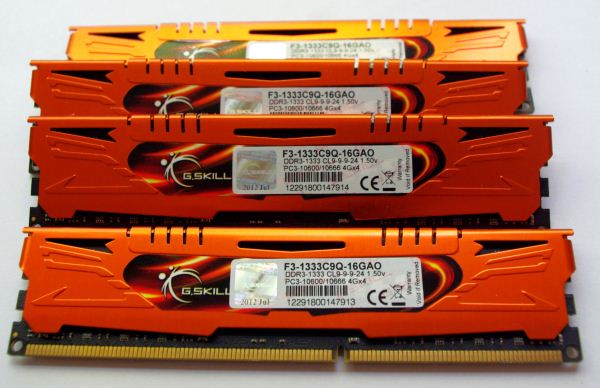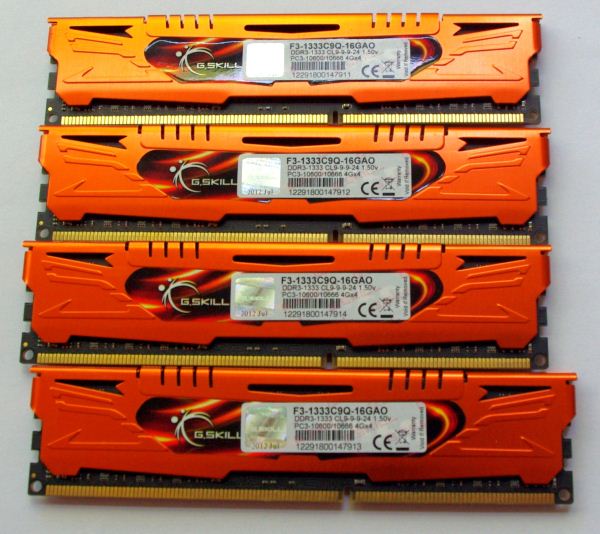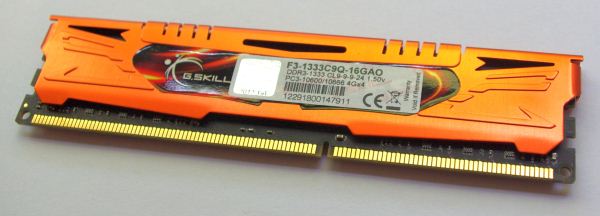Memory Performance: 16GB DDR3-1333 to DDR3-2400 on Ivy Bridge IGP with G.Skill
by Ian Cutress on October 18, 2012 12:00 PM EST- Posted in
- Memory
- G.Skill
- Ivy Bridge
- DDR3
At the lowest end of our testing, we have a 16GB DDR3-1333 9-9-9 kit on hand. When DDR3 was first released, the main speed available was DDR3-800, but enough time has passed that this has phased out and now 1333 MHz is the new ‘minimum’. With the prices of memory as they are, this kit from G.Skill currently retails for $75, meaning that a massive amount of memory is available for all at a reasonable level. To put this into contrast, I remember spending ~$240 on a 2x2 GB Kit of DDR2-800 5-5-5 about 5-6 years ago – we can now get four times the capacity for less than a third of the price.
DDR3-1333 sits at the bottom end, but within months we can imagine DDR3-1600 taking that spot – as we will see with the next kit, for $5 more we get a faster product.
Visual Inspection
Our first kit features G.Skill’s Ares branding – the Ares kits that G.Skill sell are essentially meant to be the lower profile but colored heatsinks. These heatsinks in all honesty may not be entirely necessary for cooling, but they are firmly bonded to the memory modules and removing them would be a large task and more than likely damage the module. I have seen horror stories of chips being removed along with the heatsink, making the memory unusable. As a result we cannot directly observe which ICs are being used in our kits for this review. A quick word in the ear of G.Skill and they will not tell us the information, under the guise that it is classified and if the competition wants to know what G.Skill are using, they will have to buy a kit and break it themselves. Given how small the margins are in memory sales (as well as potential market stagnation after the credit crisis), I’m not surprised with the level of secrecy.
Anyway, back to the kit:
The standard packaging at G.Skill is a rather efficient plastic container holding each of the modules. The packaging is easy enough to open, though I also found it fairly brittle, meaning small shards could break off and be easily lodged in feet. Inside the box itself is a piece of card to advertise the kit and protect the modules from each other. We also get a small G.Skill sticker for the computer case.
JEDEC + XMP Settings
| G.Skill | |||||
| Kit Speed | 1333 | 1600 | 1866 | 2133 | 2400 |
| Subtimings | 9-9-9-24 2T | 9-9-9-24 2T | 9-10-9-28 2T | 9-11-10-28 2T | 10-12-12-31 2T |
| Price | $75 | $80 | $95 | $130 | $145 |
| XMP | No | Yes | Yes | Yes | Yes |
| Size | 4 x 4 GB | 4 x 4 GB | 4 x 4 GB | 4 x 4 GB | 4 x 4 GB |
|
|
|||||
| MHz | 1333 | 1600 | 1867 | 2134 | 2401 |
| Voltage | 1.500 | 1.500 | 1.500 | 1.650 | 1.650 |
| tCL | 9 | 9 | 9 | 9 | 10 |
| tRCD | 9 | 9 | 10 | 11 | 12 |
| tRP | 9 | 9 | 9 | 10 | 12 |
| tRAS | 24 | 24 | 28 | 28 | 31 |
| tRC | 33 | 33 | 37 | 38 | 43 |
| tWR | 10 | 12 | 14 | 16 | 16 |
| tRRD | 4 | 5 | 5 | 6 | 7/6 |
| tRFC | 107 | 128 | 150 | 171 | 313 |
| tWTR | 5 | 6 | 8/7 | 9/8 | 10/9 |
| tRTP | 5 | 6 | 8/7 | 9/8 | 10/9 |
| tFAW | 20 | 24 | 24 | 25 | 26 |
| tCWL | - | 7 | 7 | 7 | 7 |
| CR | - | 2 | 2 | 2 | 2 |






















114 Comments
View All Comments
andrewaggb - Friday, October 19, 2012 - link
Fair enough :-)HisDivineOrder - Thursday, October 18, 2012 - link
You "remember" getting your first memory kit and it was for a E6400. You act like that's just this classic thing.I remember getting a memory kit for my Celeron 300a. I remember getting a memory kit for my AMD K6 with 3dNow!.
Wow, I'm old.
silverblue - Thursday, October 18, 2012 - link
I remember getting a 64MB PC100 DIMM in 2000... it was pretty much £1 a MB. Made a difference, so it was *gulp* worth it.StormyParis - Thursday, October 18, 2012 - link
Very interesting read. Thank you.rscoot - Thursday, October 18, 2012 - link
I remember paying upwards of $400 for a pair of matched 2x512MB Kingston HyperX modules with BH-5 chips. Those were the days! 300MHz at 2-2-2-5 1T in dual channel if you could put enough volts through them. Nowadays I don't think memory matters nearly as much as it did back then.superflex - Thursday, October 18, 2012 - link
Your first kit was an E6400?Let me know when you get hair down there.
My first computer was an Apple IIe in 1984, and my first build was an Opteron 170 with 400 MHz 2,2,2,5 DDR.
Magnus101 - Thursday, October 18, 2012 - link
Once again this only confirms that memory speed makes no real world difference.I mean, who in their right mind use the integrated GPU on an expensive i7-system to play metro-2033 with single digit framerate?
The only thing standing out is the Winrar compression, but, how many use winrar for compression?
Yes to decompress files it is very common but I only remember using it 2-3 times in my whole life to compress my own files.
So that isn't important to most users, except for the ones that actually use winrar to compress files.
And I don't get why the x264 encoding seemed like a big deal. The differences were very small.
It's beem the same story all the way back to the late 90;s were tests between sdr memory at 100 and 133 MHz or at different timings showed no differences in real life applications in contrast to synthetics.
But sure, if you are building a new system and choose between, let say 1333 or 1600, then a $5 difference is a no brainer.
Then again, it would make no noticeable difference anyway.
silverblue - Thursday, October 18, 2012 - link
Here's one - will it affect QuickSync in any way?twoodpecker - Monday, October 22, 2012 - link
I'd be interested in QuickSync results too. In my experience, not proven, it makes a big difference. I adjusted my memory speeds from 1600 to 2000 and noticed at some point that encoding is 25x instead of 15x. This might be due to different factors though, like software optimizations, because I didn't benchmark after adjusting mem speeds.Geofram - Thursday, October 18, 2012 - link
I don't believe he's implying that single digit frame rates on a game are going to real-life usable for anyone. I believe the point of the test was simply: "Lets take a system that is generally fast and put it in a situation where the IGP is being stressed. This will be the best-case scenario for faster RAM helping it. Lets see if it does".To me the idea was not showing everyone everyday situations where faster RAM will help them, instead it was to see where those situations might lay, by setting up a stressful situation and seeing the results. Most of the results were extremely small differences.
I agree it's not a noticeable difference in most cases. It doesn't make me feel like I should get rid of PC1333 RAM. I don't fault the logic for the tests used however. It was nice to see someone actually comparing the slight differences caused by RAM speed.